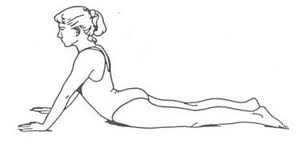The prone press up stretch, also known as the seal stretch and upward-facing dog, is one of the best stretches for your lower back. The stretch focuses on the spine itself and counteracts the pressure poor posture places on your lower back.
Perfecting the Prone Press Up Stretch
The word prone simply means lying down with your stomach toward the floor. So, to begin, lie face down on a flat surface. It can be on carpet, tile, wood flooring, or on a yoga mat. Just remember it should be a stable surface so a bed or couch will not work and can lead to injury.
How to perform the Prone Press Up Stretch
Once you are lying face down:

- Place your hands/elbows under your shoulders (like you would for a traditional push-up)
- Press on your hands/elbows to allow your shoulders and upper back to lift and curve, while keeping your hips and legs flat
- Raise to a height that allows for a comfortable, gentle stretch
- Hold for 10 seconds
- Repeat 10 times

The prone press up stretch can be done from your hands or elbows, depending on your range of flexibility.
REMEMBER: Do not stretch to the point of pain or discomfort. This can lead to injury.
Benefits of the Prone Press Up Stretch
Since the stretch focuses on the spine, many of the benefits can be felt immediately.
Prone Press Up Stretches Can:
- Counteract the pressure placed on your lower back by poor posture
- Reduce the nerve pain from a bulged or herniated disc in your lower back — a condition some in Mesa specifically address with decompression therapy for herniated disc.
- Strengthen your abdominal muscles which helps support your lower back
- Improve your range of motion
When to Perform Prone Press Up Stretches
Prone press ups should be done after you have been in forward facing positions for an extended period of time. Or anytime you feel strain or slight discomfort in your lower back.
For example, this stretch would feel great after driving a long distance, sitting all day at your desk, working in your garden, going for a long bike ride, or scrubbing the floor on your hands and knees.
When to Avoid Prone Press Up Stretches
Knowing when to perform a stretch is just as important as knowing when not perform a stretch. This helps prevent injury.
If you have a diagnosed spinal condition such as a spinal fusion, stenosis, or spondylolisthesis it's wise to consult with a medical provider, possibly even a chiropractor in Mesa, before performing this stretch.
If you experience increased pain during or after performing a prone press up stretch (or any stretch for that matter) you should contact your medical provider.
PLEASE NOTE:
- This stretch should not be done during pregnancy. If you are pregnant, you should never press your belly against the floor and stretch.
- If you have been diagnosed with spinal stenosis or spondylolisthesis, consult with your medical provider before performing this stretch.
